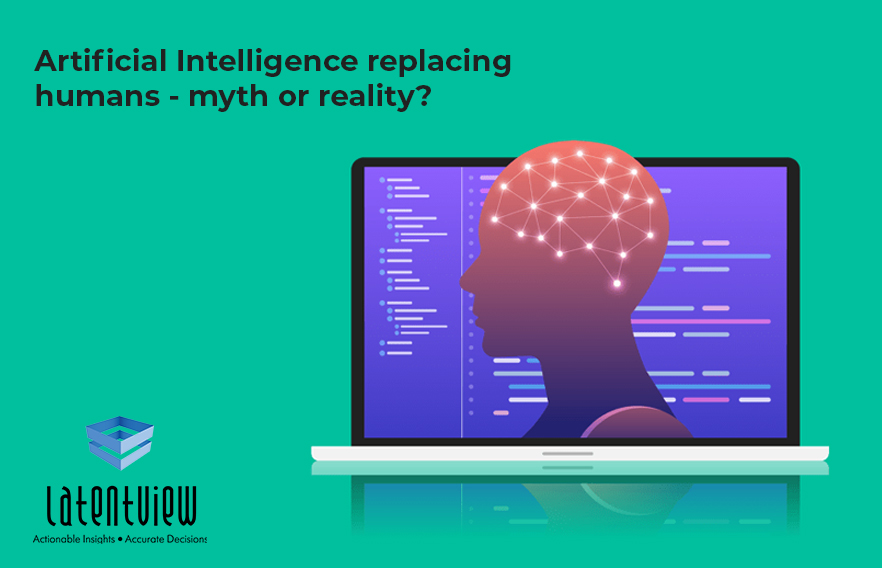AI is replacing and will replace, all we humans do and can dream of, but humans must make the decision. In the current world of Industrial Revolution 4.0, Artificial Intelligence is the most debated topic and the kind of impact AI & ML is bringing to the table is beyond explanation. Though there is widespread belief of AI and robots replacing humans in the workplace, analysts still believe that it brings with it more opportunities for humans to take advantage of. In this blog, we will discuss in detail about the risks of Artificial Intelligence and whether the general belief of “Artificial Intelligence replacing humans” is indeed a myth or reality.
Artificial Intelligence replacing humans in daily routines
Day in and day out, one of the many things we routinely do is composing mails. And off late, we can see that the amount of Artificial Intelligence interfering in it is exponentially growing. Few years back, auto correct was considered a huge breakthrough but now, not just auto correct, AI can indeed compose mails. Every time you get a mail and the moment you click reply, you instantaneously get a list of suggestions to compose the mail; nine out of ten times, the suggestions do make sense. People might think that these suggestions are just a one liner and can never replace a detailed mail, but one must remember that this is just the beginning. It is just a matter of time, these one-line suggestions are upgraded to a detailed mail too.
So, not just composing mails but starting from your alarm tune to scheduling an appointment with you physician, AI can replace many day-to-day human activities seamlessly and perfectly, running our lives on autopilot.
How can AI be so smart?
What we see now is not the result of a day’s work. It is culmination of tons of research and loads of training. Advanced machine learning, and deep learning techniques are deployed to ensure the output of an AI algorithm is accurate and relevant. Listed below are some of the steps that organizations could take to leverage the power of AI in not just day-to-day activities, but also to streamline business operations.
Define your problem & solution
For any AI application, the first step is to design the problem and understand the scope and spectrum of the solution too. Once the problem statement is defined, then the different perspectives and the underlying complex scenarios are sketched out for which the learning must be ingested. Consider the AI in composing mails, here the problem statement is to recommend a suitable reply to a given mail. In this case, we can have different kind of mails like:
- To get your approval
- Asking for a time slot
- Waiting for a feedback
The list might go on and on, hence for each of these scenarios one must design the right kind of reply mails.
Train your model/algorithm
Once you define the scenarios, you must train the model for each of those scenarios. Bigger the training dataset, better the results. Nowadays, the training of a model is not just restricted to the dataset you build before you implement but keeps adding up from the actual usage too. The results of the model are feedback into the training dataset thereby ensuring that the model keeps learning. Reinforcement learning is one such area where developments are happening at a rapid pace, making a huge impact in machine learning process.
Adding human intelligence
Irrespective of how good our training dataset is, it is necessary to bring in human intelligence to the mix. We might have a huge training dataset, but we must ensure the best practises and most accepted solutions are incorporated. Going back to the same example of composing mails, we might have thousands of mail replies to train our AI system for a given scenario, but we must keep in mind the expert opinion to be considered. In addition to the output (reply recommendation) based on the training dataset, we can also add suggestions which might be a better reply for a given scenario. This will always add value to the AI engine as it brings in not just the historical reference based on training data, but also incorporates the best in class practise.
What about AI in conversational analytics?
Data analytics is on all-time high and the number of organizations incorporating data-driven decision making is increasing multifold every single day. Descriptive Analytics, Diagnostic Analytics, Predictive Analytics and Prescriptive Analytics are at their pinnacle of growth. Now, it is time to move forward and organizations feel conversational analytics can help them get insights faster and reduce the time in decision making. Conversational analytics is tied to almost all different kinds of analytics and AI is a game changer in this domain. Natural language processing (NLP) and Natural language generation (NLG) are on the verge of establishing its fullest potential in every aspect of Conversational analytics. With multiple high-end technologies and improvements in Deep learning, NLP & NLG can only get stronger from here.
Smartphones and personal assistants
When personal assistants were integrated to smart phones, customers were amazed at the ease in which actions were performed within the mobile environment. There were even comparisons made between a virtual smartphone assistant and a human being. Some felt the response from an AI driven assistant can easily overcome the human errors and can also bring in the emotional aspect of a human being.
Customer care and chatbots
The beginning of personal assistants in smart phones has made a huge impact in the customer care industry. In the quest to answer every single customer query with accurate information, companies started engaging with AI and analytics firms to deploy virtual customer care assistants and chatbots that can engage with any number of customers parallelly just like a real person. Once the business workflow and schema of engagement is trained, then AI can step in to replace humans and do the grunt work? Though the virtual assistants might have issues in handling new queries that are not trained and expected, it can certainly be programmed in a better way to tackle such scenarios which is again similar to how we train real customer care executives. The bottom line is, AI can learn fast and can produce results error free, but it is the responsibility of humans to ingest that core intelligence for an AI module.
Conversational analytics and domain intelligence
According to Garter, “By 2020, 50% of analytical queries either will be generated via search, natural language processing or voice, or will be automatically generated.”
Players like ThoughtSpot, Tableau’s Ask Data and LatentView Analytics have already started making inroads into conversational analytics. Organizations feel that a conversational business assistant will help them get insights better and faster as there aren’t enough analysts to answer all questions and to process huge amount of data that is being generated rapidly. Once again, a thing to be noted here is, even though AI can make significant progress in NLP and NLG, without domain knowledge and intelligence, these assistants cannot help organizations to get the right set of actionable insights. This is exactly where human intelligence comes into play. Along with AI, if experts can feed in the best-in-class domain expertise, then the conversational assistant becomes meaningful and more powerful driving the digital transformation of companies.
Finally, is “Artificial Intelligence replacing humans”?
As discussed earlier, AI is indeed making huge impact in the decision making of humans. Personal assistants, chatbots and conversational assistants are helping individuals, customers, decision makers simplify their day-to-day routine. This has lead to concerns about robots replacing humans in the workplace. While the opinion might be that AI is taking us by a surprise and may hit us like a storm, it must be remembered that all these are the pioneering efforts of humans. AI can certainly replace human activities when it comes to grunt work, but that human intelligence is a core component in the effective functioning of AI. To conclude, we believe AI will replace manual work but not human intelligence.
Helping your business realize the promise of AI
LatentView Analytics is working with companies across industries to harness the power of AI to transform their business processes, drive innovation and enhance customer experience. To know how LatentView Analytics can help you plan for AI and leverage its potential within your business, please get in touch with us at sales@latentview.com





